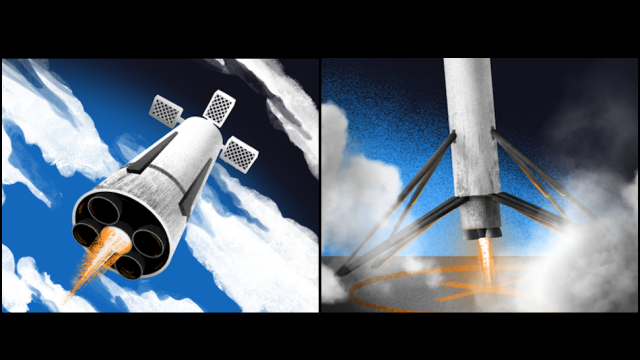Roscosmos is moving ahead with plans to build Russia’s first reusable rocket. Glancing at the design, it appears the Russian space agency doesn’t feel the need to reinvent the wheel, given the vehicle’s uncanny resemblance to the SpaceX Falcon 9.
Roscosmos signed a contract with the Progress Rocket Space Centre to sketch out a preliminary design for the Amur-SPG reusable rocket, reports Russian news agency TASS. The inaugural launch is planned for 2026, when the methane-powered rocket will take off from the Vostochny spaceport in eastern Russia. Roscomos is hoping for individual launch costs no greater than $US22 ($31) million, with the total cost of developing the system at around $US880 ($1,233) million.
As Ars Technica space reporter Eric Berger rightly pointed out in a recent tweet, the new design seems uncomfortably recognisable.
“Russia has clearly decided that if you can’t beat ‘em, join ‘em with its new design for a reusable booster,” he wrote. “Alas, no flights until at least 2026 means it will be at least 15 years behind the Falcon 9. Russia is lucky SpaceX doesn’t innovate, hah.”
It’s a step in the right direction, but they should really aim for full reusability by 2026. Larger rocket would also make sense for literal economies of scale. Goal should be to minimize cost per useful ton to orbit or it will at best serve a niche market.
— Elon Musk (@elonmusk) October 6, 2020
This design, even if preliminary, is clearly inspired by the first and only reusable rocket currently in existence, the SpaceX Falcon 9. In addition to borrowing SpaceX’s overarching design strategy, the reusable rocket will feature landing legs, a faring, and grid fins similar to those seen on the Falcon 9. The reusable second stage will land at predetermined landing pads in eastern Russia and be carried back to the cosmodrome, either by a heavy Mi26 transport helicopter or by rail, according to Roscosmos.
Alerted by Berger’s tweet, Elon Musk responded with words of support, but he also offered some unsolicited advice.
“It’s a step in the right direction, but they should really aim for full reusability by 2026,” tweeted the SpaceX CEO. “Larger rocket would also make sense for literal economies of scale. Goal should be to minimise cost per useful ton to orbit or it will at best serve a niche market.”
Indeed, Amur will have a lift capacity of 11.6 tons (10.5 metric tons) to low Earth orbit (LEO), and its second-stage will consist of a non-recoverable, single-use engine. That said, a larger version is also being planned for the future, with a lift capacity of 13.8 tons (12.5 metric tons) to LEO. By comparison, the Falcon 9 can carry a payload of 25 tons (22.8 metric tons). So Musk’s points are well taken, including the remark about the rocket not being completely reusable. SpaceX is currently working on exactly this, with its upcoming Starship.
[referenced id=”1237369″ url=”https://gizmodo.com.au/2020/08/spacex-starship-prototype-completes-its-first-hop/” thumb=”https://gizmodo.com.au/wp-content/uploads/2020/08/06/v8j9fxr6uldtey47zqqw-300×174.png” title=”SpaceX Starship Prototype Completes Its First ‘Hop’” excerpt=”SpaceX’s plans to build a reusable rocket capable of landing on the Moon and Mars took a major leap forward on Tuesday, following the first successful test of the Starship system.”]
Amur won’t be a carbon copy of Falcon 9, however. As TASS reports, the Russian design calls for a wider rocket at 13.5 feet (4.1 meters), compared to the 12.1 feet (3.7 metre) diameter of the Falcon 9. And instead of nine Merlin engines, Amur will be powered by five RD-0169A methane-oxygen engines, which are currently in development. At the launch pad, Amur will stand nearly 54.86 m tall (55 meters), compared to the 63.40 m-tall (63.3-metre) Falcon 9.
Russia did a similar thing during the 1980s, coming up with a reusable orbiter that was upsettingly similar to NASA’s Space Shuttle. Called Buran, the spacecraft only flew once, but it used a single Energia rocket (as opposed to the two solid rocket boosters and external fuel tank used by the Space Shuttle), which in hindsight might have actually been a better idea, from a safety perspective.
